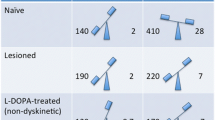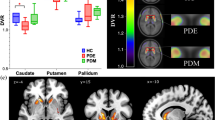Summary
We have quantified by receptor autoradiography the number of NK1 receptors, using [125I] Bolton-Hunter labeled substance P, in striatum and pallidum (internal (GPi) or external (GPe) segment) of patients suffering from Alzheimer's (AD) and Parkinson's disease (PD). When compared to non-neurologic controls, a significant increase in the number of NK1 sites has been observed in the striatum of PD patients. No significant differences were observed for the GPi and GPe. We observed no significant differences from controls in the number of NK1 sites in the striatum and pallidum of AD cases. However, the number of NK1 sites in the striatum of AD patients was significantly lower than that of PD patients. These results show that the expression of NK1 receptors in the basal ganglia is affected in PD.
Similar content being viewed by others
References
Albin RL, Young AB, Penney JB (1989) The functional anatomy of basal ganglia disorders. TINS 12(10): 366–375
Araujo DM, Lapchak PA, Robitaille Y, Gauthier S, Quirion R (1988) Differential alteration of various cholinergic markers in cortical and subcortical regions of human brain in Alzheimer's disease. J Neurochem 50(6): 1914–1923
Arenas C, Alberch J, Perez-Navarro E, Salsona C, Marsal J (1991) Neurokinin receptors differentially mediate endogenous acetylcholine release evoked by tachykinins in the neostriatum. J Neurosci 11(0): 2332–2338
Artymyshyn R, Smith A, Wolfe BB (1990) The use of3H standards in125I autoradiography. J Neurosci Methods 32: 185–192
Bannon MJ, Elliott PJ, Bunney EB (1987) Striatal tachykinin biosynthesis: regulation of mRNA and peptide levels by dopamine agonists and antagonists. Mol Brain Res 3: 31–37
Bannon MJ, Poosch MS, Haverstick DM, Mandal A, Xue IC-H, Shibata K, Dragovic LJ (1992) Preprotachykinin gene expression in the basal ganglia: characterization of mRNAs and pre-mRNAs produced by alternate RNA splicing. Mol Brain Res 12: 225–231
Beal MF, Mazurek MF, Lorenz LJ (1987) Substance P-like immunoreactivity is reduced in Alzheimer's disease cerebral cortex. Neurology 37: 1205–1209
Beaujouan JC, Torrens Y, Saffroy M, Glowinski J (1986) Quantitative autoradiographic analysis of the distribution of binding sites for [125I] Bolton Hunter derivatives of eledoisin and substance P in the rat brain. Neuroscience 18(4): 857–875
Buck SH, Burcher E (1986) A family of peptides with a brood of “receptors”. TPS 7: 65–68
Buck SH, Helke CJ, Burcher E (1986) Pharmacological characterization and autoradiographic distribution of binding sites for iodinated tachykinins in the rat central nervous system. Peptides 7: 1109–1120
Burcher E (1988) The study of tachikinin receptors. Clin Exp Pharmacol Physiol 16: 539–543
Chesselet M-F, Affolter H-U (1987) Preprotachykinin messenger RNA detected by in situ hybridization in striatal neurons of the human brain. Brain Res 410: 83–88
Chesselet M-F, Robbins E (1989) Regional differences in substance P-like immunoreactivity in the striatum correlate with levels of pre-protachykinin mRNA. Neurosci Lett 96: 47–53
Clevens RA, Beal MF (1989) Substance P-like immunoreactivity in brains with pathological features of Parkinson's and Alzheimer's diseases. Brain Res 486: 387–390
Cruz CJ, Beckstead RM (1989) Nigrostriatal dopamine neurons are required to maintain basal levels of substance P in the rat substantia nigra. Neuroscience 30(2): 331–338
Dietl M, Probst A, Palacio JM (1986) Mapping of substance P receptor sites in the human brain: high densities in the substantia innominata and effect of senile dementia. Soc Neurosci Abstracts 12: 831
Dietl M, Sanchez M, Probst A, Palacios M (1989) Substance P receptors in the human spinal cord: decrease in amyotrophic lateral sclerosis. Brain Res 483: 39–49
Ehringer H, Hornykiewick O (1960) Verteilung von Noradrenalin und Dopamin (3-Hydroxytyramin) im Gehirn des Menschen und ihr Verhalten bei Erkrankungen des extrapyramidalen Systems. Klin Wochenschr 38: 1236–1239
Elde R, Schalling M, Caccatelli S, Nakanishi S, Hökfelt T (1990) Localization of neuropeptide receptor mRNA in rat brain: initial observations using probes for neurotensin and substance P receptors. Neurosci Lett 120: 134–138
Freund TF, Powell J, Smith AD (1984) Tyrosine hydroxylase-immunoreactive boutons in synaptic contact with identified striatonigral neurons, with particular reference to dendritic spines. Neuroscience 13: 1189–1215
Gerfen CR (1991) Substance P (neurokinin 1) receptor mRNA is selectively expressed in cholinergic neurons in the striatum and basal forebrain. Brain Res 556: 165–170
Gerfen CR, Enger TM, Mahan LC, Susel Z, Chase TN, Monsma FJ, Sibley DR (1990) D1 and D2 dopamine receptor-regulated gene expression of striatonigral and striatopallidal neurons. Science 250: 1429–1432
Goto S, Hirano A, Matsumoto S (1990) Immunohistochemical study of the striatal efferents and nigral dopaminergic neurons in Parkinsonism-dementia complex on Guam in comparison with those in Parkinson's and Alzheimer's diseases. Ann Neurol 27: 520–527
Gottfries CG, Adolfson R, Aquilonius SM, Carlson A, Eckernäs SA, Nordberg A, Oreland L, Svennerholm L, Wiberg Ao, Winblad B (1983) Biochemical changes in dementia disorders of Alzheimer type (AD/5DAT). Neurobiol Aging 4: 261–271
Graybiel AM (1986) Neuropeptides in the basal ganglia. In: Martin JB, Barchas JD (eds) Neuropeptides in neurologic and psychiatric disease. Association for research in nervous and mental disease, vol 64. Raven Press, New York, pp 135–161
Hornykiewick O, Kish SJ (1986) Biochemical pathophysiology of Parkinson's disease. Adv Neurol 45: 19–34
Joyce JN (1991a) Differential response of striatal dopamine receptor subtypes and cholinergic muscarinic receptors to the loss of dopamine. I. Effects of intranigral or intracerebroventricular 6-hydroxydopamine lesions of the mesostriatal dopamine system. Exp Neurol 113: 261–276
Joyce JN (1991 b) Differential response of striatal dopamine receptor subtypes and cholinergic muscarinic receptors to the loss of dopamine. II. Effects of 6-hydroxydopamine or colchicine microinjections in the VTA or reserpine treatment. Exp Neurol 113: 277–290
Joyce JN (1993) Differential response of striatal dopamine receptor subtypes and cholinergic muscarinic receptors to the loss of dopamine. III. Effects in Parkinson's disease. Brain Res 600: 156–160
Joyce JN, Hensler JG, Tejani-Butt SM (1991) Neurochemical lesioning techniques for assessing regulation of monoamine receptors. In: Conn PM (ed) Methods in neurosciences, 7. Academic Press, San Diego, pp 216–240
Katchaturian ZS (1985) Diagnosis of Alzheimer's disease. Arch Neurol 42: 1097–1105
Lee J-M, McLean S, Maggio JE, Zamir N, Roth RH, Eskay RL, Bannon MJ (1986) The localization and characterization of substance P and substance K in striatonigral neurons. Brain Res 37: 152–154
Lindefors N, Brodin E, Tossman U, Segovia J, Ungersteadt U (1989) Tissue levels and in vivo release of tachykinins and GABA in striatum and substantia nigra of rat brain after unilateral striatal dopamine denervation. Exp Brain Res 74: 527–534
Mai JK, Stephens PH, Hoft A, Cuello AC (1986) Substance P in the human brain. Neuroscience 17(3): 709–739
Marakami S, Kubota Y, Kito S, Shimada S, Takagi H, Wu J-Y, Inagaki S (1989) The coexistence of substance P- and glutamic acid decarboxylase-like immunoreactivity in entopeduncular neurons of the rat. Brain Res 485: 403–406
Mauborgne A, Javoy-Agid F, Legrand JC, Agid Y, Cesselin F (1983) Decrease of substance P-like immunoreactivity in the substantia nigra and pallidum of parkinsonian brains. Brain Res 268: 167–170
Murray AM, Weihmueller F, Marshall JF, Joyce JN (1991) Disturbances in pre- and postsynaptic dopamine systems in Parkinson's and Alzheimer's disease. Soc Neurosci Abstracts 21: 1260
Pearce BR, Palmer AM, Bowen DM, Wilcock GK, Esiri MM, Davison AN (1984) Neurotransmitter dysfunction and atrophy of the caudate nucleus in Alzheimer's disease. Neurochem Pathol 2: 221–231
Pollack AE, Wooten GF (1992) D2 dopaminergic regulation of striatal preproenkephalin mRNA levels is mediated at least in part through cholinergic interneurons. Mol Brain Res 13: 35–41
Reinikainen K, Paljarvi L, Haloen T, et al (1988) Dopaminergic system and monoamine oxidase-B activity in Alzheimer's disease. Neurobiol Aging 9: 245–252
Reisine TD, Yamamura HI, Brid ED, Spokes E, Enna SJ (1978) Pre- and postsynaptic neurochemical alterations in Alzheimer's disease. Brain Res 159: 447–481
Roberts SJ, Hanaway J (1971) Atlas of the human brain in section. Lea and Febiger, Philadelphia, p 95
Sakurada T, Alufuzoff I, Winblad B, Nordberg A (1990) Substance P-like immunoreactivity, choline acetyltransferase activity and cholinergic muscarinic receptors in Alzheimer's disease and multiinfarct dementia. Brain Res 521: 329–332
Sivam SP (1991) Dopamine dependent decrease in enkephalin and substance P levels in basal ganglia regions of postmortem parkinsonian brains. Neuropeptides 18: 201–207
Sivam SP, Breese GR, Krause JE, Napier TC, Mueller RA, Hong J-S (1987) Neonatal and adult 6-hydroxydopamine-induced lesions differentially alter tachykinin and enkephalin gene expression. J Neurochem 49(5): 1623–1633
Shults CW, Quirion R, Jensen RT, Moody TW, O'Donohue TL, Chase TN (1982) Autoradiographic localization of substance P receptors using125I substance P. Peptides 3: 1073–1075
Sugimoto T, Takada M, Kaneko T, Mizuno N (1984) Substance P-sositive thalamocaudate neurons in the center median-parafascicular complex in the cat. Brain Res 323: 181–184
Tenovuo O, Kolhinen O, Laihinen A, Rinne UK (1990) Brain substance P recetors in Parkinson's disease. Adv Neurol 53: 145–148
Tenovuo O, Rinne UK, Viljanen MK (1984) Substance P immunoreactivity in the post-mortem parkinsonian brain. Brain Res 303: 113–116
Tomlinson BE, Blessed G, Roth M (1970) Observations on the brains of demented old people. J Neurol Sci 11: 205–242
Young WS III, Bonner TI, Brann MR (1976) Mesencephalic dopamine neurons regulate the expression of neuropeptide mRNAs in the rat forebrain. Proc Natl Acad Sci USA 83: 9827–9831
Author information
Authors and Affiliations
Rights and permissions
About this article
Cite this article
Rioux, L., Joyce, J.N. Substance P receptors are differentially affected in Parkinson's and Alzheimer's disease. J Neural Transm Gen Sect 6, 199–210 (1993). https://doi.org/10.1007/BF02260922
Received:
Accepted:
Issue Date:
DOI: https://doi.org/10.1007/BF02260922




